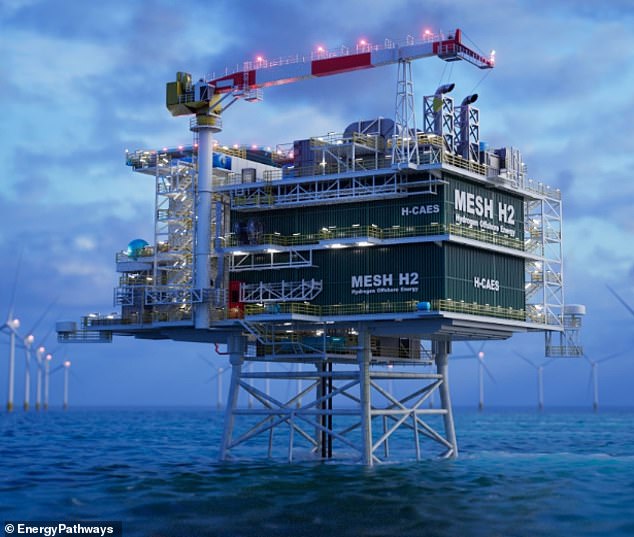Britain is heading for a crunch in energy storage. As wind and solar supply more of the country’s power, storing electricity for when the weather doesn’t cooperate is becoming critical.
Yet the nation has some of the lowest energy storage levels in Europe.
France, Germany and Italy each hold roughly ten times more gas in reserve. In the UK, there would be just six days of supply if imports were cut.
That matters because, even as the country aims to eliminate unabated fossil fuel use from the power system by 2035, the need for dispatchable energy, available on demand, will remain.
The grid’s increasing reliance on intermittent renewables only heightens the risk of supply-demand mismatches. Already, surplus wind power costs households and businesses £2billion a year in curtailment payments. By 2030, that figure could climb to £10billion.
Enter the Marram Energy Storage Hub, or MESH. It is one of a handful of new storage schemes intended to plug the gap.

MESH will sit 11 miles off the coast of Lancashire and is designed to function as a multi-technology underground battery
Developed by EnergyPathways, MESH will sit 11 miles off the coast of Lancashire and is designed to function as a multi-technology underground battery.
If built as planned, it would store up to 20 terawatt-hours (TWh) of energy, about 7 per cent of the UK’s annual electricity demand. The facility would combine three storage methods: natural gas, compressed air and hydrogen.
The first phase of the project, known as Marram A, focuses on repurposing depleted gas reservoirs to provide 17TWh of storage, equivalent in size to the ageing Rough facility off the Yorkshire coast. This initial segment is expected to cost £200million and could be operational by 2028.
To put that investment into context, it is around a tenth of the estimated expenditure to fully update Centrica’s Rough operation, an endeavour that is mired in wrangling over subsidies and which may well even be shelved.
Later phases of MESH will see the construction of 20 salt caverns for compressed air and hydrogen, with a total hydrogen storage capacity of 2.8TWh and a power output of 640MW. The compressed air system, with 400MW capacity, is expected to offer multi-day power, well beyond the capabilities of battery installations.
Together, these systems will eventually provide up to 700MW of low-carbon flexible power, helping to smooth fluctuations in wind output.
MESH has already secured interest from investors and support from several engineering partners. Alongside Wood Group, EnergyPathways has partnered with KBR, Hazer Group, Costain and Siemens Energy, which has experience developing similar long-duration storage systems in Germany. A final investment decision is due once permitting is complete and finance is secured.
The site’s location is no accident. The north-west of England is emerging as a hub for energy transition projects, with large offshore wind capacity, major hydrogen and carbon capture initiatives such as HyNet, and strong industrial demand.
MESH will tap into this ecosystem, connecting directly to offshore wind farms in the Irish Sea and feeding into the National Grid via existing export infrastructure.
Unlike lithium-ion batteries, which store electricity for minutes or hours, MESH is designed for endurance. Its compressed air and hydrogen systems will allow for dispatchable generation over multiple days.
Hydrogen will play a growing role as the UK’s market matures, replacing the initial use of natural gas. The salt caverns planned for storage are well suited to the task, chemically inert, self-sealing and already used elsewhere in Europe.
The benefits are threefold. First, MESH would improve Britain’s energy security by reducing reliance on imported gas. Second, it would reduce curtailment of wind power, turning wasted energy into usable supply.
Third, it would provide a reliable source of low-carbon electricity, supporting the UK’s 2030 target for clean power. The system’s carbon emissions will be at least 30 per cent lower than unabated gas power, and the site will be electrified and powered by renewables. That figure will reduce to zero with hydrogen decarbonisation displacing gas use.
EnergyPathways says it expects to begin earning revenue within two and a half years of final go-ahead. The project is designed with a 25-year lifespan and forecasts an internal rate of return above 20 per cent.
Around 500 jobs are expected to be created during construction, supporting the government’s goal of a just transition for the offshore workforce.
Political winds are also favourable. The new government has signalled strong support for energy storage as part of its push for clean power by 2030. Ministers have underlined the importance of domestic supply in the face of geopolitical uncertainty.
European electricity imports are increasingly unreliable, and recent blackouts in France, Spain and Portugal have highlighted the risks of overdependence on cross-border flows.
With costs of net zero beginning to show up in energy bills, ministers are under pressure to deliver reliable infrastructure that doesn’t break the bank. Storage, particularly long-duration capacity, offers a way to meet climate goals while keeping costs down.
Projects like MESH will not be enough on their own, but they offer a template for how the UK might store more of its homegrown energy, rather than letting it blow away.
DIY INVESTING PLATFORMS

AJ Bell

AJ Bell
Easy investing and ready-made portfolios

Hargreaves Lansdown

Hargreaves Lansdown
Free fund dealing and investment ideas

interactive investor

interactive investor
Flat-fee investing from £4.99 per month

InvestEngine

InvestEngine
Account and trading fee-free ETF investing
Trading 212
Trading 212
Free share dealing and no account fee
Affiliate links: If you take out a product This is Money may earn a commission. These deals are chosen by our editorial team, as we think they are worth highlighting. This does not affect our editorial independence.
This article was originally published by a www.dailymail.co.uk . Read the Original article here. .

